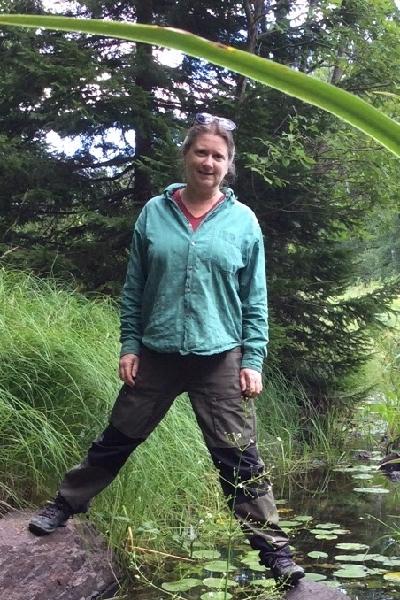Eva Lindström
Professor at Institutionen för ekologi och genetik; Limnologi
- Telephone:
- +46 18 471 64 97
- E-mail:
- Eva.Lindstrom@ebc.uu.se
- Visiting address:
- Evolutionsbiologiskt centrum (EBC)
Norbyvägen 18 D
752 36 Uppsala - Postal address:
- Norbyvägen 18 D
752 36 Uppsala
Download contact information for Eva Lindström at Institutionen för ekologi och genetik; Limnologi
- CV:
- Download CV
- ORCID:
- 0000-0001-8920-3071
More information is available to staff who log in.
Short presentation
The diversity of bacteria and other microorganisms in nature is enormous. Due to the usage of molecular tools, we now know that these communities change over time and space, but we don’t know why and if it matters for their role in ecosystems. In other words we lack basic knowledge about microbial ecology, and we don’t know if it is fundamentally different compared to ecology of other organisms. This is what I want to find out!
Keywords
- bacteria
- diversity
- lake
- limnology
Biography
Since 2013 I am a professor in Biology at Uppsala University at the Limnology program, where I am also a part of the Microbial Ecology group.
Previous achievements include a PhD degree in Limnology at Uppsala University in 1999, and a Docent title from the same university in 2004. I have held two postdoc positions, one in 1999-2000 at the Department of Limnology of the Austrian Academy of Sciences and one in 2004 at Université du Québec à Montréal.
During my time at Uppsala University I have been teaching corresponding to 10-50% of a full time position including course development and responsibility for 9 different undergraduate and Masters courses. I have done more than 400 hours of lectures in such courses.
Courses I currently teach as course coordinator:
Biodiversity and ecosystem functioning
Vattenvård (in Swedish)
I am also a member of the teacher team of the following courses (all in Swedish):
Research
Two questions are central for my research:
1) Which factors are shaping microbial diversity?
2) Does the function of the microbial community in the ecosystem depend on the diversity or community composition?
My projects
My research is within the field of metacommunities, i.e. to what extent communities and ecosystems are influenced by other communities in the surroundings (i.e. the metacommunity). I am also interested in the importance of microbial diversity for the functioning of ecosystems..
The following questions are addressed in current and recent projects:
1) How important is dispersal of bacterial cells for bacterial community composition and functioning? Can massive dispersal of cells (mass effects) over shadow environmental steering factors for community composition? Is the sequence of dispersal of importance due to so called priority and monopolization effects? What about stochastic processes such as drift? Does the importance of these factors differ over season, among lakes of different types and among organism groups? What are the consequences of dispersal and community assembly for the functioning of microbial communities?
2) Are blooms by the nuisance algae G.semen promoted by increased concentrations of iron? What are the ecosystem consequences of G.semen blooms?
In general, questions about biogeography and biodiversity-ecosystem function relationships have been little addressed in microbial communities due to methodological constraints. Today we use novel DNA-sequencing techniques. This development has opened up the door for a new set of questions since diversity can be analysed to a great precision and depth. Finally we can address the over-all question of if microorganism biogeography and biodiversity follow similar rules as that of larger organisms or if they are fundamentally different. Only future will tell if this information will make us rewrite ecology textbooks!
Further, this research aims to increase our understanding of the role of microorganisms in ecosystems, where they play central roles in for instance carbon cycling. Thus, my research deals with the small players with global impact.
Recent and current projects have been made possible by financial support from for instance Vetenskapsrådet, The Wenner-Gren foundation, Carl Tryggers Stiftelse för Vetenskaplig forskning, Stiftelsen Oscar och Lili Lamms minne, Biodiversa, the Åforsk foundation and Stiftelsen Olle Engkvist Byggmästare.
See also my google scholar profile.
Group members
PhD students:
Sofia Papadopoulou (ecosystem consequences of dispersal)
Berenike Bick (community assembly, main supervisor Silke Langenheder)
Previous group members (selection):
Jürg Brendan Logue (PhD student, biogeography)
David Lymer (PhD student, viral ecology)
Martin Andersson (PhD student, bacterial diversity-ecosystem relationships)
Xinmei Feng (postdoc, biogeography)
Jérôme Comte (postdoc, biogeography)
Ina Severin (postdoc, diversity and function from a biogeography perspective)
Johanna Sjöstedt (postdoc Microbial diversity and ecosystem functioning)
Karen Lebret (postdoc Ecological tipping points, bacteria and phytoplankton interactions)
Sophia Renes (Ph D student, Resilience of microbial communities, SLU)
Karla Münzner (Ph D student, causes and consequences of algal blooms)
Ingrid Sassenhagen (postdoc, parasites of phytoplankton blooms)
Theresa Lumpi (PhD student, community assembly)
Josefin Nilsson (PhD student, Högskolan i Halmstad)

